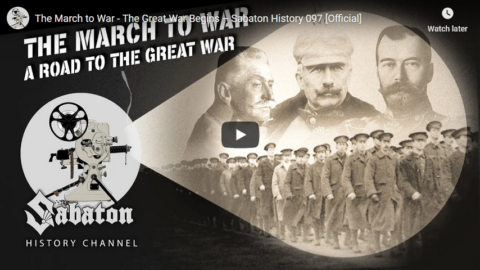Sabaton History
Published 10 Dec 2020August 1914. Europe marched to war. Heavy boots resounded in unison over the pavement, while proud banners flew overhead the soldiers. Their leaders had promised them a short war. In a few weeks, maybe a couple of months, each man would return home as a hero. Cavalrymen in embroidered coats, white gloves, and plumed caps rode ahead, surging towards the front in search of promised glory. But the perceived enthusiasm, eagerly exploited by the propaganda, was not widely shared. Instead, it was the gloomy atmosphere, full of fear and doubt.
Support Sabaton History on Patreon: https://www.patreon.com/sabatonhistory
Listen to “The March to War” on the album Primo Victoria (Re-Armed): https://music.sabaton.net/PrimoVictoria
Listen to Sabaton on Spotify: http://smarturl.it/SabatonSpotify
Official Sabaton Merchandise Shop: http://bit.ly/SabatonOfficialShopHosted by: Indy Neidell
Written by: Markus Linke and Indy Neidell
Directed by: Astrid Deinhard and Wieke Kapteijns
Produced by: Pär Sundström, Astrid Deinhard and Spartacus Olsson
Creative Producer: Maria Kyhle
Executive Producers: Pär Sundström, Joakim Brodén, Tomas Sunmo, Indy Neidell, Astrid Deinhard, and Spartacus Olsson
Community Manager: Maria Kyhle
Post-Production Director: Wieke Kapteijns
Editor: Karolina Dołęga
Sound Editor: Marek Kaminski
Maps by: Eastory – https://www.youtube.com/c/eastory
Archive: Reuters/Screenocean – https://www.screenocean.comColorizations by:
Klimbim
Cassowary ColorizationsSources:
Imperial War Museums: HU 68424, HU 68463, HU 68487, Q 81765, PST 2734, Q 81840B, Q 93521, Q 53472, Q70232, Q 115391
Narodowe Archiwum Cyfrowe
National Archives NARA
National Army Museum
Rijksmuseum
Bundesarchiv
Library of Congress
Picture of Three Emperors courtesy of Anna Moscowriuo
Pictures from French Manufacture of Weapons and Cycles courtesy of mediatheques.saint-etienne.fr
Picture from the Battle of Bulair courtesy of Dupnitsa Municipality, Historical Museum
Pictures of the French departure to War, courtesy of 66emeri from Wikimedia
Picture from the Battle of Mons courtesy of Champagnepapi22 from Wikimedia Commons
Map of Europe courtesy of Altenhof from Wikimedia CommonsAll music by: Sabaton
An OnLion Entertainment GmbH and Raging Beaver Publishing AB co-Production.
© Raging Beaver Publishing AB, 2019 – all rights reserved.
December 11, 2020
“The March to War” – The Great War Begins – Sabaton History 097 [Official]
The Salvage of Pearl Harbor Pt 3 – The First and the Last
Drachinifel
Published 2 Dec 2020Today we look at the salvage efforts on the USS Shaw, first vessel salvaged from the remains of the attack on Pearl Harbor and the work on the last two vessels under the team’s care, the Utah and Oklahoma
Sources:
www.amazon.co.uk/gp/product/B00C0JIXJO
https://www.history.navy.mil/our-coll…
www.amazon.co.uk/Pearl-Harbor-Fleet-Salvage-Appraisal/dp/0898755654
www.amazon.co.uk/Descent-into-Darkness-Harbour-Divers/dp/0891417451
Videos – US National Archives / US Department of DefenseFree naval photos and more – www.drachinifel.co.uk
Want to support the channel? – https://www.patreon.com/Drachinifel
Want a shirt/mug/hoodie – https://shop.spreadshirt.com/drachini…
Want a poster? – https://www.etsy.com/uk/shop/Drachinifel
Want to talk about ships? https://discord.gg/TYu88mt
Want to get some books? www.amazon.co.uk/shop/drachinifelDrydock
Episodes in podcast format – https://soundcloud.com/user-21912004
“Politically correct language … seemed like a nice, polite, and Canadian sort of thing to do”
Meaghie Champion discusses politically correct language in The Line:

Source: https://www.deviantart.com/blamethe1st/art/Statist-And-Anarchist-063-Political-Correctness-589944623
I grew up in the 1970s and ’80s. I have never lived in a world without what we now call “political correctness” — typically understood to mean using a kind of stilted and artificial language in order to atone for the disadvantages and slights suffered by marginalized groups and avoid inflicting new ones. Politically correct language required more effort to communicate, but it seemed like that effort was worth it to not offend people. It seemed like a nice, polite, and Canadian sort of thing to do.
I went along with political correctness out of a sincere desire to be accommodating to disadvantaged and dis-enfranchised groups. This became especially true after I learned about the “Sapir Whorf theory of psycho neurolinguistics.” The theory suggests that language shapes our perception of reality; that by altering the way we talk, we can shift the way we think — and, thus, collectively, we can shape reality itself. From this, it seemed logical to “de-gender” language or stop using stereotypes. It seemed like a small ask. Maybe I personally couldn’t solve big problems that concerned me as a good liberal … i.e. things like poverty or world hunger, but I could be nice in how I expressed myself and try to use language that everybody was using to be equitable and more fair.
What I didn’t understand, then, was that this precedent set a trap in which many good, well-intentioned liberals are finding themselves stuck. It’s no longer about ameliorating past sins: there is a project afoot to re-make the English language. The purpose of this project is to re-engineer how people think about certain subjects like gender, sex, and race, while skipping the necessary prerequisites of persuasion and logic. Conservative positions are declared off limits, even bigoted, simply by shaping the way we are allowed to talk about them.
Right now, even as I type this, there is a veritable army of academics hard at work on what they call “de-colonizing” and “de-gendering” language at many universities and colleges. There are tens of thousands of activists and academics in universities and online organizing and pushing for ever-changing rules to be enforced as it relates to the English language. It’s a multi-million-dollar industry in academia and woke corporatism. And it’s already starting to spill over into government regulations and enforcement.
I love the English language. I have been a voracious reader since childhood. I thrill at well-spoken and written prose and poetry. A finely turned witticism or fantastic mot juste can break my heart with its perfection. Further, I’m First Nations, and that love of the English language has also carried me into a love of the study of my tribal cradle tongue “Hul’qumi’num.” Shouldn’t I, as a First Nations person, be in favour of de-colonizing the English language? No. No, I do not think so. I have little patience or regard for any effort that makes language a less workable and functional tool of human endeavour. I identify strongly as a writer, and I take this assault upon the tool with which I conduct my craft very personally.
Shooting the Webley-Fosbery Automatic Revolver – Including Safety PSA
Forgotten Weapons
Published 10 Aug 2017Following up yesterday’s look at the history and mechanics of the Webley-Fosbery self-cocking revolvers [posted here], today we are out at the range to do some shooting with one.
In terms of handling, it is a comfortable gun to shoot, albeit with some exaggerated recoil because of the very high bore axis relative to the hand. It has an interesting two-part recoil sensation, because the upper assembly takes quite a long time to return forward into battery.
Most importantly, we discovered that this particular Webley-Fosbery has a worn hammer engagement, which results in the firing pin coming into contact with cartridge primers even when it is in the safety notch. In other words, it can — and will — sometimes fire when the action is closed and without any manipulation of the trigger. This is a condition that could happen to any Fosbery revolver, so owners should handle them with this possibility in mind! This is also a great example of why gun safety rules are redundant — occasionally guns do have mechanical failures, so don’t point them at anything you don’t want to shoot!
Thanks to Mike Carrick of Arms Heritage magazine for providing this Webley-Fosbery for this video! See his regular column here: https://armsheritagemagazine.com
Cool Forgotten Weapons merchandise! http://shop.bbtv.com/collections/forg…
http://www.patreon.com/ForgottenWeapons
If you enjoy Forgotten Weapons, check out its sister channel, InRangeTV! http://www.youtube.com/InRangeTVShow
QotD: Airbrushing out the worst parts of “Lost Cause” mythology
The South could have become a running sore, a cauldron of low-level insurrection and guerilla warfare that blighted the next century of U.S. history. Instead, it is now the most patriotic region of the U.S. – as measured, for example, by regional origins of U.S. military personnel. How did this happen?
Looking back, we can see that between 1865 and around 1914 the Union and the former South negotiated an imperfect but workable peace. The first step in that negotiation took place at Appomattox, when the Union troops accepting General Robert E. Lee’s surrender saluted the defeated and allowed them to retain their arms, treating them with the most punctilious military courtesy due to honorable foes.
Over the next few years, the Union Army reintegrated the Confederate military into itself. Confederate officers not charged with war crimes were generally able to retain rank and seniority; many served in the frontier wars of the next 35 years. Elements of Confederate uniform were adopted for Western service.
The political leaders of the revolt were not executed. Instead, they were spared to urge reconciliation, and generally did. By all historical precedent they were treated with shocking leniency. This paid off.
Of course, not all went smoothly. The Reconstruction of the South between 1863 and 1877 was badly bungled, creating resentments that linger to this day and – in the folk memory of Southerners – often overshadow the harms of the war itself. The condition of emancipated blacks remained dire.
But overall, the reintegration of the South went far better than it could have. Confederate nationalism was successfully reabsorbed into American nationalism. One of the prices of this adjustment was that Confederate heroes had to become American heroes. An early and continuing example of this was the reverence paid to Robert E. Lee by Unionists after the war; his qualities as a military leader were extolled and his opposition to full civil rights for black freedmen memory-holed.
Lee’s heroism and ascribed saintliness would layer become a central prop in “Lost Cause” romanticism, which portrayed the revolt as an honorable struggle for a Southern way of life while mostly airbrushing out – but sometimes, unforgiveably, defending – the institution of slavery. Even today, the “soft” airbrushing version of Lost Cause retains a significant hold on Southerners who would never dream of defending slavery.
Eric S. Raymond, “Unlearning history”, Armed and Dangerous, 2017-09-22.






